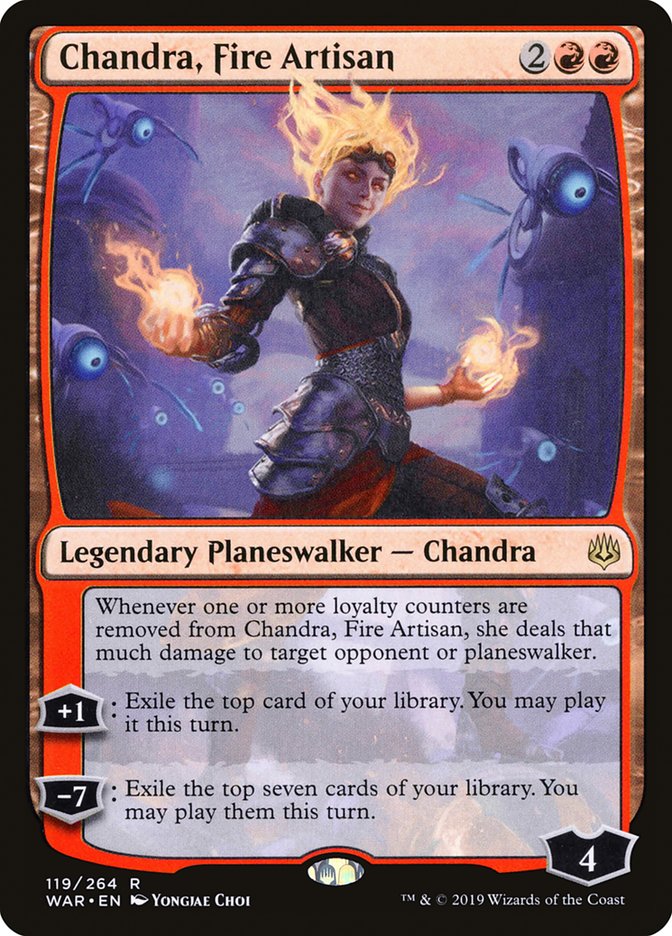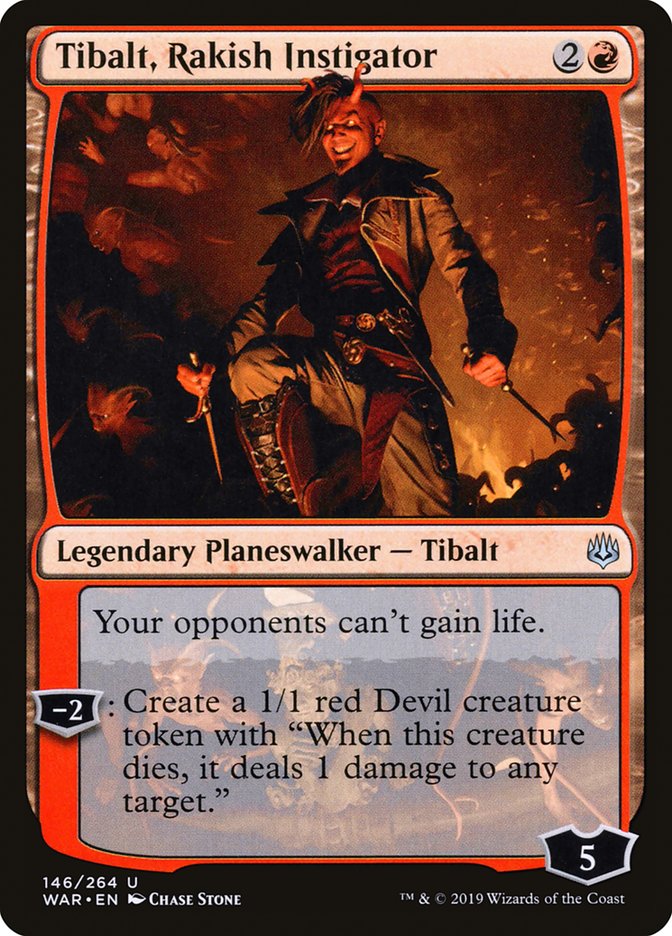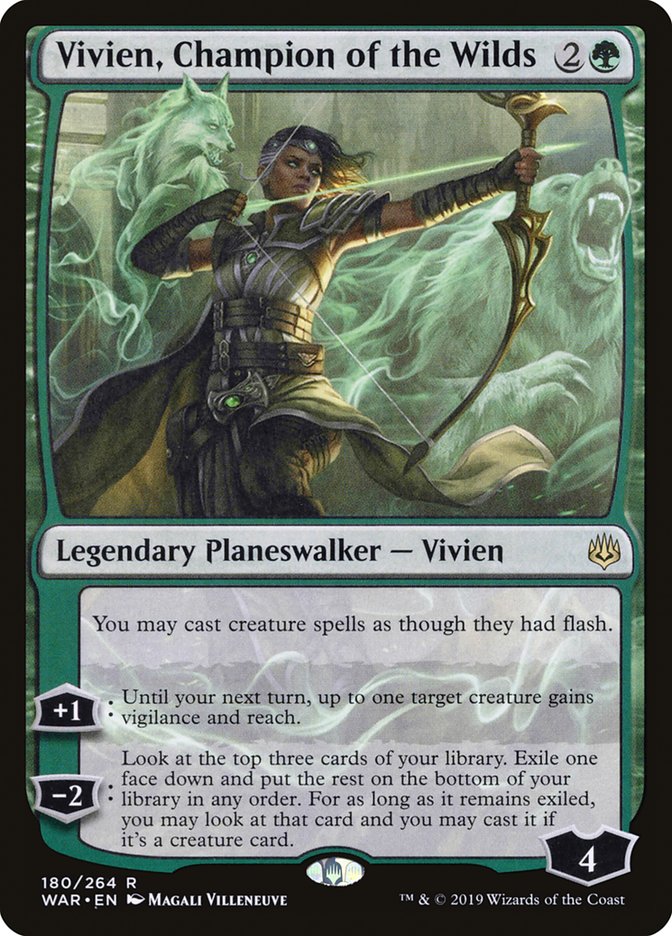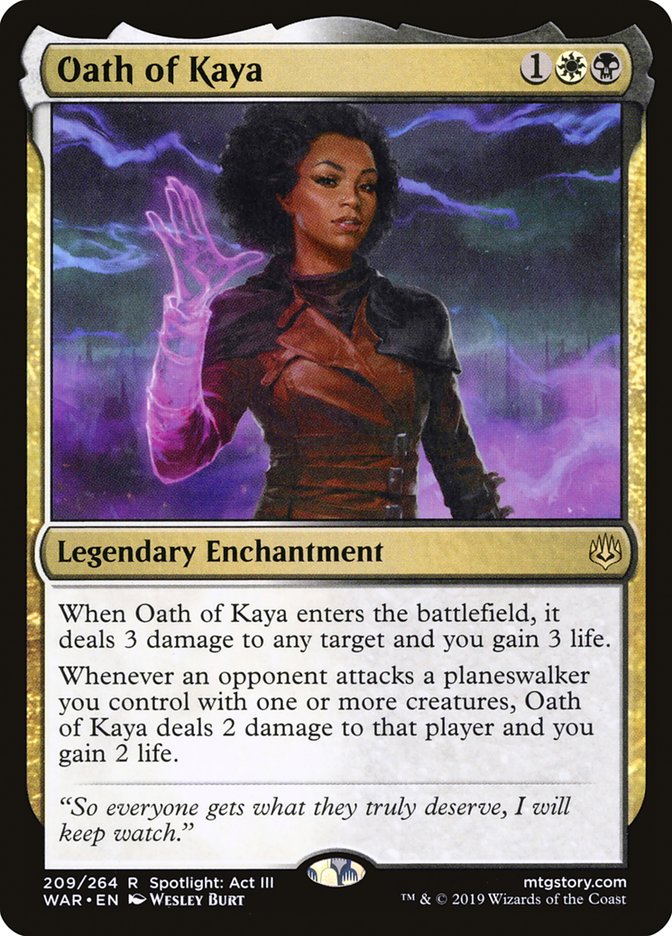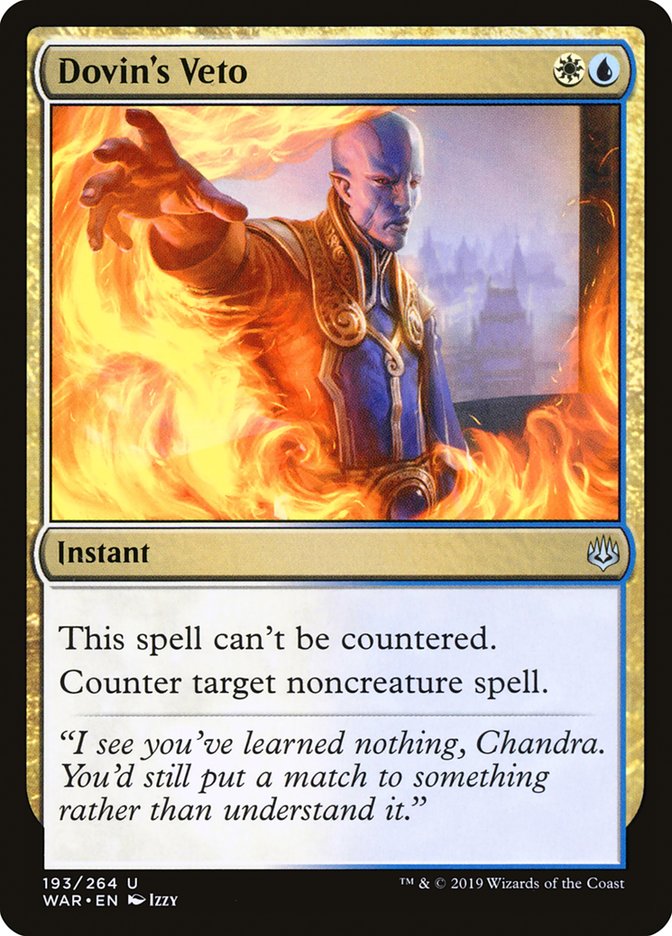War of the Spark Standard remains in its infancy, with just a handful of tournaments, including just one Standard Open at SCG Richmond, providing the data Magic players will scour as they make their deckbuilding decisions heading into the Standard Open in Syracuse. Despite a card and set pool leaning on the larger side, War of the Spark has done a ton to shake the foundations of Standard, introducing a slew of powerful cards that buffed up a bunch of existing archetypes and spawning new ones.
Alas, as is true in the first weeks of a new Standard format, the SCG Richmond was won by a deck featuring a manabase comprised entirely of Mountains:
Creatures (20)
- 4 Fanatical Firebrand
- 4 Ghitu Lavarunner
- 4 Goblin Chainwhirler
- 4 Viashino Pyromancer
- 4 Runaway Steam-Kin
Planeswalkers (4)
Lands (20)
- 20 Mountain
Spells (16)

Despite being a deck almost directly ported from the previous format, Will Pulliam still employed a couple of new planeswalkers to flesh out his deck with some new additions:
The shift away from reliance on Experimental Frenzy for a fairly similar role-player that excels against other creature decks was a very smart move by Pulliam, given enchantment hate seeing an increase thanks to Simic Nexus being the deck to beat coming into the event. Short of answers like Vraska’s Contempt and Conclave Tribunal, Chandra, Fire Artisan deals a ton of damage to be dealt with by opposing creatures.
While Mono-Red Aggro stole the show, a new kid on the block made an appearance not once, but twice in the Top 8 of the Open:
Creatures (29)
- 4 Llanowar Elves
- 2 Shalai, Voice of Plenty
- 2 Knight of Autumn
- 2 Deputy of Detention
- 4 Hydroid Krasis
- 4 Growth-Chamber Guardian
- 4 Frilled Mystic
- 4 Incubation Druid
- 3 God-Eternal Oketra
Planeswalkers (7)
Lands (24)
Sideboard

Creatures (29)
- 4 Llanowar Elves
- 2 Shalai, Voice of Plenty
- 2 Knight of Autumn
- 2 Deputy of Detention
- 4 Hydroid Krasis
- 4 Growth-Chamber Guardian
- 4 Frilled Mystic
- 4 Incubation Druid
- 3 God-Eternal Oketra
Planeswalkers (7)
Lands (24)

Team Nova teammates Rudy Briksza and Harlan Firer took this innovative Bant Flash-esque deck to a very solid finish, and the deck is currently making waves throughout the Magic Arena ranked queues and Magic Online Standard Leagues. The primary engines of the deck are two new three-mana planeswalkers:
One stops your opponent from playing at instant speed, while the other lets you operate almost entirely at instant speed. It’s simple and powerful deckbuilding design, which you want in a Week 1 format. If your goal is to try something new, it had best be powerful and hard to interact with, something the Vivien and Teferi dream team accomplishes quite well.
Bant Midrange and Mono-Red Aggro were just two of the many talks of the town over the last week or so, but there are many other decks making splashes as the Standard metagame evolves around new cards and new strategies. Today, I’m going to dive into the strengths and weaknesses of decks you must prepare for if you want to be successful at SCG Syracuse this weekend.
The Top Tier
These decks are either the top performers of last Standard or archetypes that have already put up significant results this Standard format. Do notignore these.
Creatures (20)
- 4 Fanatical Firebrand
- 4 Ghitu Lavarunner
- 4 Goblin Chainwhirler
- 4 Viashino Pyromancer
- 4 Runaway Steam-Kin
Planeswalkers (4)
Lands (20)
- 20 Mountain
Spells (16)

I’ve already covered Mono-Red Aggro a bit above, but it’s important to understand that this archetype is finally back to a power level only overshadowed by the Hazoret the Fervent / Chandra, Torch of Defiance / Glorybringer days, thanks to the addition of the newest Chandra. This coincides with a dip in popularity of Wildgrowth Walker decks like Sultai Midrange, meaning the deck is poised to be a mainstay of early War of the Spark Standard.
Pros: Has the format’s fastest goldfish of Turn 4. Runaway Steam-Kin is a big reason for this, as it allows you to generate a bunch of extra mana that helps you unleash a flurry of burn spells, as well as grow to 4/4 very quickly to provide a ton of power in just one body. Additionally, Chandra, Fire Artisan, as previously mentioned, gives the deck a new four-mana card advantage engine that dodges Mortify and other Disenchant-type effects, unlike Experimental Frenzy.
Cons: Being the deck to beat heading into the weekend means it’ll have a target on its head, which means an uptick in removal spells like Moment of Craving and Vraska’s Contempt, as well as cards like Elite Guardmage and Knight of Autumn that both block and provide a reasonable life boost upon entering the battlefield. It will be important to take this into account, should you choose this deck to play next weekend.
Planeswalkers (7)
Lands (26)
Spells (27)

Esper Control has only stood to gain with the addition of some powerful new answers and planeswalkers, the biggest of which is Teferi, Time Raveler, which did quite a bit to make the Simic Nexus matchup much more palatable. Dovin’s Veto also provides a nice freeroll upgrade to Negate, making sure those critical noncreature spells being countered end up in the graveyard, guaranteed.
Pros: Powerful and flexible. Esper Control features a vast library of tools to help tune the right 75 for a given weekend. This is the type of deck that will heavily reward someone with their finger on the pulse of the metagame, as one Esper Control decklist could be half a dozen cards off from the top-performing lists for the following weekend.
Cons: Esper Control’s biggest Achilles’ heel is its manabase. Your lands don’t always enter the battlefield untapped without having to pay a significant amount of life, thanks to an extremely color intensive spell suite. You’ll lose a handful of games here and there to aggressive decks looking to punish you for playing the Thought Erasure / Absorb / Kaya’s Wrath curve. Additionally, depending on your configuration, you will likely struggle against the Nexus of Fate decks, especially Game 1, where you are drawing dead to a pile of cards like Moment of Craving and Cast Down.
Planeswalkers (3)
Lands (25)
Spells (32)
- 4 Opt
- 4 Search for Azcanta
- 1 Blink of an Eye
- 4 Nexus of Fate
- 4 Root Snare
- 2 Sinister Sabotage
- 4 Chemister's Insight
- 4 Growth Spiral
- 4 Wilderness Reclamation
- 1 Callous Dismissal
Sideboard

The Week 1 boogeyman of SCG Richmond failed to have any players break through into the Top 8 of the event, but Simic Nexus was the most-represented deck of the second day of competition and carried four players to a Top 16 finish, just one match win shy of a Top 8 berth. The deck’s raw power level and difficult-to-interact-with combo pieces gives many decks in the format fits, and a robust sideboard plan of powerful creatures give the deck resiliency against hateful sideboards.
Pros: A powerful and consistent Game 1 plan against the field that can only really be beaten by the raw aggression of decks like Mono-Red Aggro and aggressive white strategies means that most of the time you will head to the sideboard games only having to win one of the two. Wilderness Reclamation is challenging for most decks’ Game 1 configurations to handle, and the resiliency and consistency provided by newcomers Narset, Parter of Veils and Tamiyo, Collector of Tales mean that minimal disruption won’t cut the mustard unless backed up with a quick clock.
Cons: The aggressive decks are your worst matchups, and will prey on the games where you are either unable to capitalize on Wilderness Reclamation in a timely manner, or you stumble and are unable to overpower your opponent on mana (and subsequently turns of the game) quickly. Additionally, Thief of Sanity out of the sideboard of the Esper Control deck or the maindeck of Esper Midrange can be an absolute beating if not answered fairly quickly, as they can very easily turn your deck’s greatest strengths against you.
Creatures (11)
Planeswalkers (9)
- 3 Teferi, Hero of Dominaria
- 2 Liliana, Dreadhorde General
- 3 Teferi, Time Raveler
- 1 Sorin, Vengeful Bloodlord
Lands (26)
Spells (14)

Esper Midrange revolves around Hero of Precinct One alongside a pile of multicolored spells to give a more midrange-esque flavor to the Esper shard. The sacrifice of a higher top-end for a creature-centric gameplan gives the deck the pressure it needs to stand toe-to-toe with decks like Simic Nexus, as the clock that Hero of Precinct One provides means that they have significantly less time to set up shop.
Pros: The deck is sort of a more proactive version of Esper Control by virtue of playing creatures in the maindeck, meaning you aren’t reliant on having to overwhelm your opponent in card advantage or reach a Teferi, Hero of Dominaria ultimate to lock up the game. The multidimensional aspect of the deck means that it can attack from various angles, making it much less straightforward to interact with than traditional Esper Control.
Cons: By virtue of being a midrange deck, you can run into the wrong-half problem of drawing to many answers and not enough threats or vice versa at times, as there is less in the way of card draw and library manipulation. Thief of Sanity in the maindeck looks embarrassing at times against the more aggressive decks in the format, for example, as is Hostage Taker against decks like Esper Control or Simic Nexus.
Creatures (29)
- 4 Llanowar Elves
- 2 Shalai, Voice of Plenty
- 2 Knight of Autumn
- 2 Deputy of Detention
- 4 Hydroid Krasis
- 4 Growth-Chamber Guardian
- 4 Frilled Mystic
- 4 Incubation Druid
- 3 God-Eternal Oketra
Planeswalkers (7)
Lands (24)

The newest archetype to spawn from War of the Spark, Bant Midrange shows off the power of Vivien, Champion of the Wilds and Teferi, Time Raveler working in tandem to control the pace of the game in your favor. God-Eternal Oketra seems very impressive here as well, turning the mana creatures drawn in the late game into fine draws, as the 4/4 generated by her ability quickly takes over a game.
Pros: Excellent matchups against any other midrange, control, or Nexus deck. Operating at instant speed via Vivien makes the Frilled Mystics much more powerful in this shell than in others, since it isn’t as obviously telegraphed with Vivien on the battlefield. Teferi is an absolute nightmare for Esper Control and Simic Nexus, and God-Eternal Oketra very quickly dominates the battlefield against decks like Sultai Midrange.
Cons: Another deck that features a clunky three-color manabase and is heavily reliant on the mana creatures to pull ahead on mana early leaves you highly susceptible to the most aggressive decks in the format. Solid anti-aggro cards exist in droves in the Bant colors, but an occasionally painful manabase full of clunky, expensive cards mean that you can frequently end up dying before you’ve had time to deploy all your spells.
Creatures (25)
- 3 Adanto Vanguard
- 4 Skymarcher Aspirant
- 4 Benalish Marshal
- 4 Dauntless Bodyguard
- 4 Venerated Loxodon
- 3 Hunted Witness
- 3 Law-Rune Enforcer
Lands (20)
Spells (15)
Sideboard

White-based aggro, frequently splashing blue, was very popular in last season’s Standard, but has had little representation in the first couple of weeks of this format. A part of this is because the deck’s best new addition is Gideon Blackblade, who unfortunately competes for a three-drop slot already occupied by History of Benalia and Benalish Marshal, cards that likely won’t be budging from these decklists to make room for Gideon anytime soon. As such, the deck plateaued a bit while the rest of the format’s decks got stronger. That being said, it is still a punishing deck capable of quickly generating a boatload of power thanks to cards like Venerated Loxodon and is still a deck to pay attention to moving forward.
Cons: Much like Mono-Red Aggro, this deck is punishing against stumbles and possesses one of the fastest kills in the entire format. Sultai Midrange’s diminished presence for the time being means that the deck is fairly low on predators and the deck is likely well-positioned at the moment.
Cons: As previously mentioned, the deck flatlined in power level compared to other decks in the format. While Simic Nexus, for example, got Tamiyo, Collector of Tales and Blast Zone, white-based aggro got Gideon Blackblade and…Law-Rune Enforcer.
Honorable Mentions
While I don’t expect the following decks to show up in force, they have at least shown some signs of life in this format and have put up results here and there and are as such worth mentioning.
Creatures (4)
Planeswalkers (9)
- 2 Liliana, Dreadhorde General
- 4 Nicol Bolas, Dragon-God
- 2 Narset, Parter of Veils
- 1 Ugin, the Ineffable
Lands (25)
Spells (22)

Creatures (13)
Planeswalkers (3)
Lands (21)
Spells (23)

Planeswalkers (6)
Lands (26)
Spells (28)

This format is still wide open for now, but some decks have already shown much more promise and have the foundations in place to begin tuning for an expected metagame. SCG Syracuse will put to the test many theories and ideas players have been working on in the last couple of weeks, and I imagine we’ll have a much better idea of what the long-term top brass of Standard will be come this time next Monday.
Learning the ins and outs of the decks above, as well as knowing how to attack the weaknesses of each one, is a recipe for success this coming weekend. This Standard format is incredibly skill-intensive and rewards players who know exactly what to expect every turn of every game of every round.
Study up!


